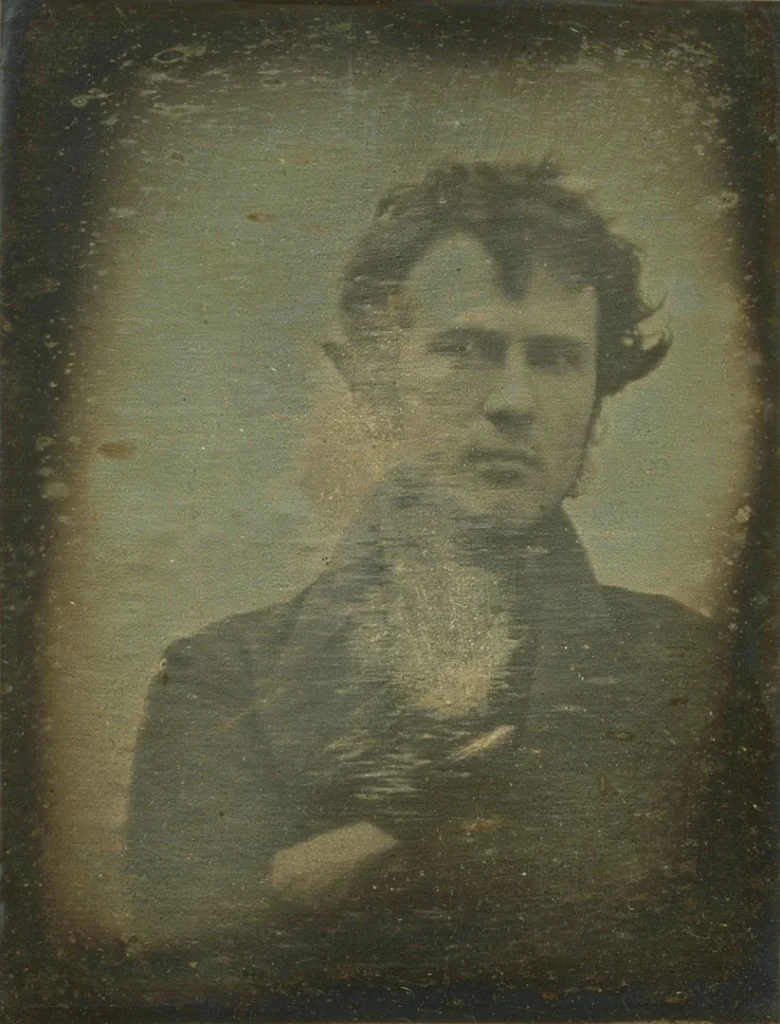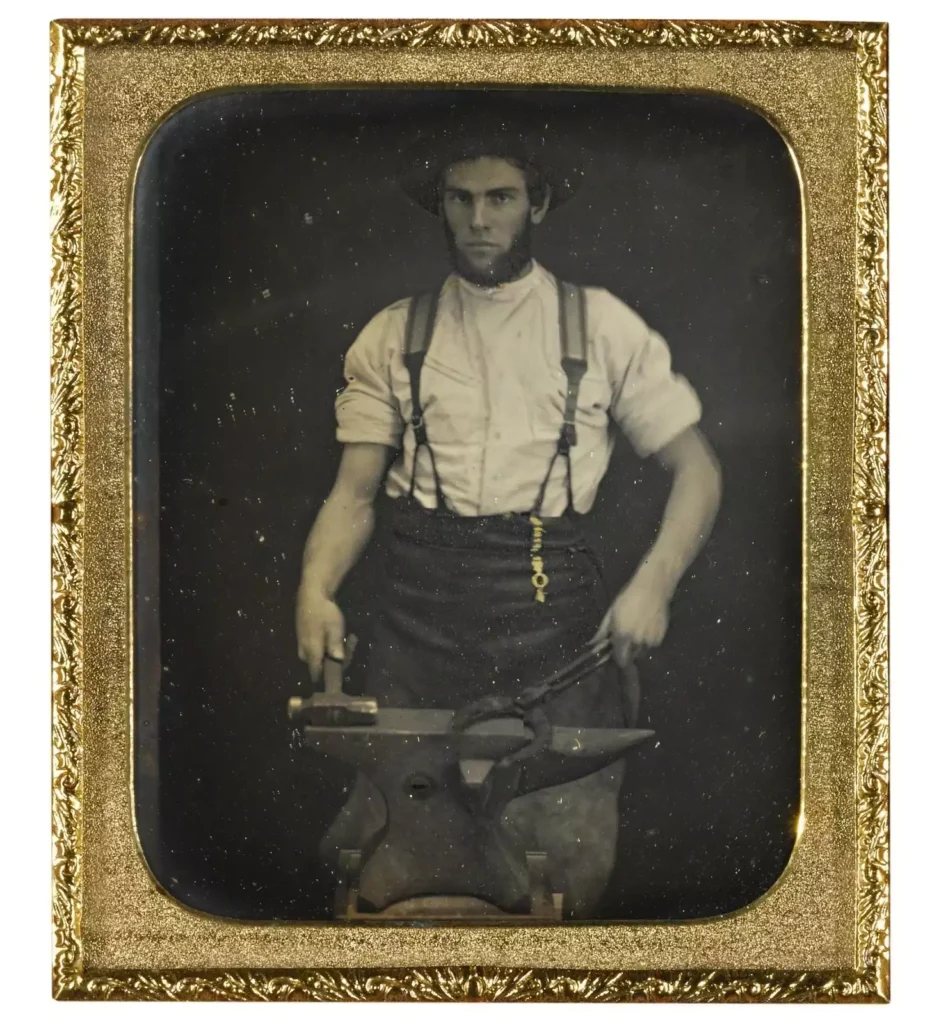First Selfie

In October 1839, a young man named Robert Cornelius sat alone in his yard, experimenting with a makeshift camera that utilized a lens made from opera glasses. Little did he know that he would go down in history as the first person to take a selfie. In modern times, taking a selfie is quick and effortless, but for Robert, it requires him to stand still and gaze forward for an astonishing 15 minutes. The resulting image, featuring his upturned collar and unkempt hair, is now displayed at the Library of Congress alongside his other works. This inaugural selfie was captured using a daguerreotype, which differs significantly from the photographs we are accustomed to today.
Daguerreotype Image

In the past, the initial commercially prosperous technique for capturing an image was referred to as a daguerreotype, named after its creator, Louis Jacques Mande Daguerre. This method produces a solitary image on a silver-plated copper plate. Despite being weighty and inflexible, the daguerreotype is precise and clear, particularly for its era, and possesses a fragile surface akin to a mirror.
The World’s First Photo

The first photograph of a person was not taken intentionally, unlike the first selfie. This occurrence occurred in the 1800s while Louis Daguerre attempted to capture an image of Paris’ Boulevard du Temple. If you examine the photograph closely, you can spot a man receiving a shoe shine on one of the city streets. This photograph is unique because, in those days, people had to remain stationary for several minutes to take a photo of them. Fortunately for Louis Daguerre, the man getting his shoes polished was unwittingly posing for the photograph while standing still.
Hidden Mother Portrait


Considering how time-consuming it was to capture a high-quality photograph, one can easily fathom the challenge of keeping a younger subject still for the process. As evidenced in these 19th-century family portraits, the presence of a strangely draped figure in the background serves a specific purpose. Frequently, it was the mother who dressed up in such a manner to hold her child securely and soothe them during the shoot. Some women would masquerade as chairs or curtains, while others merely covered themselves with a rug to achieve the ideal Victorian-era portrait. Without this technique, the resulting pictures would have been a jumbled mess due to everyone moving about. Such images may seem eerie now, but they were a vital part of photographic history.
Victorian Photographs
Speaking of Victorian photographs, have you ever seen one where the subjects are smiling? Highly unlikely, as the process involved in taking such photos was uncomfortable. Photographers would use back braces to keep tissues still for a prolonged period. Unfortunately, these braces were far from comfortable. Victorian photographs were not always flawless, despite using various techniques to perfect the shot. Thus, most of them were manually retouched with a pencil, similar to the early version of Photoshop.

Additionally, Queen Victoria was a pioneer in photography and even coined the term “photo,” being the first British monarch to be captured on camera. The word “photography” has its roots in Greek, meaning “drawing with light.”
Nowadays, the availability of technology has made it possible to capture images using various devices. You can easily take photos on your laptop, phone, or smartwatch. It’s difficult to determine the exact number of photos taken daily, but it’s estimated that over 1 trillion pictures are captured yearly. Additionally, statistics reveal that there are 95 million images uploaded on Instagram daily and over 300 million on Facebook.
According to research conducted at Wake Forest University, many believe we have a more photogenic side. Interestingly, their findings support this belief, revealing that our left side tends to be more aesthetically pleasing. This is possible because the left side of our face is more expressive, displaying a more excellent range of emotions than the right side.
The Abandoned Cameras on the Moon

In 1969, the Apollo 11 Mission landed on the moon, and the crew brought along 12 Hasselblad cameras to capture significant images of the lunar surface. However, these cameras were abandoned on the moon, and their current whereabouts are unknown. This decision was because Neil Armstrong and his team deemed the cameras too weighty to transport back to Earth, especially since they had already collected more than 50 pounds of rock samples to bring home. Nonetheless, they did manage to retrieve the film from the cameras.
The Oldest Photography

At approximately two centuries old, the oldest photograph known to humanity is genuinely remarkable. What’s more impressive is the fact that it took roughly eight hours to capture this photograph. The credit goes to Joseph Nicéphore Niépce, who caught the picture from a window in San Luis de flare, France, titled “View from the Window.” The painting depicts a castle and other structures in the surrounding area. Niépce achieved this feat by projecting the image from the window onto a sensitized plate, which was then used to transfer the details to a piece of paper. Despite its delicate nature, the image has survived through the years and can still be viewed today.
Most Famous Photograph

The most widely seen photograph in history is not what you might expect – it is not of a well-known personality or an iconic monument. Surprisingly, it is the default wallpaper of Windows XP, known as Bliss. This unaltered image displays a lush green hill and a serene blue sky filled with clouds. Although it is impossible to determine the exact number of individuals who have viewed this photo, it is estimated to be in the billions.
The Most Expensive Photograph Ever Sold

In 1999, Andreas Gorski captured the world’s priciest photograph, “Rhine II,” featuring the Rhine river in Western Europe. The image portrays the river between green grass and beneath the sky with a minimalistic aesthetic. Gorski edited the photograph by digitally eliminating dog walkers and a building before it was finalized. In 2011, the image was sold for $4,338,500 at a New York auction. Although photographer Peter Lik claims to have sold a photograph worth over $7 million, the buyer’s anonymity makes it impossible to verify this sale officially.
The Greatest Portrait Photographer

Yusuf Karsh, a Canadian Armenian photographer, must be mentioned when talking about renowned photographers. He’s recognized as the most outstanding portrait photographer of the 20th century. His collection includes photographs of notable figures such as Winston Churchill, Queen Elizabeth II, Grace of Monaco, Albert Einstein, Audrey Hepburn, Pablo Picasso, and many others. Any list of eminent photographers would be incomplete without him.
Harry Pointer and His Feline Companions
Count me in when it comes to browsing through adorable pictures of tiny kittens. It’s no surprise that it remains one of the most popular searches on Google, but did you know that the concept of cat photography is much older than you might think? It dates back to the 19th century. The trend began in the 1870s when Harry Pointer snapped a photo of his cat. From there, he continued to capture images of his feline companions lounging, drinking milk, and sleeping in baskets. Pointer became a specialist in cat photography, and his captivating works still hold up today. One of his images even depicts a cat attempting to ride a bicycle!
